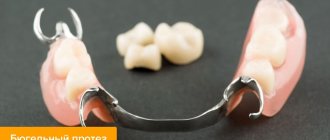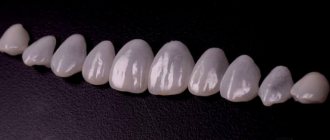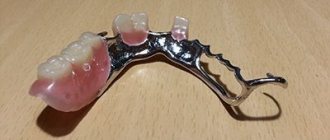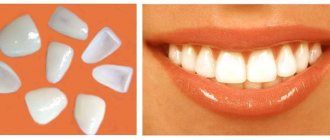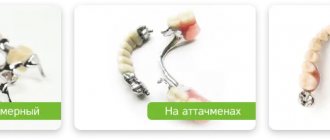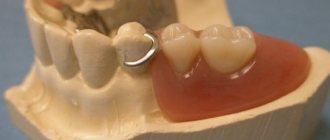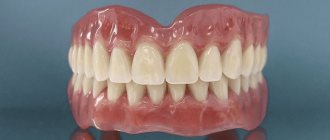What is a splinting clasp prosthesis?
A clasp-type splinting prosthesis is a type of prosthetic structure, the base of which has the shape of an arc and is made of metal. When put on, the product fits tightly to the gum and is attached to the inside of the supporting teeth. Special fastening elements (clasps) provide reliable fixation of movable units.
In addition to the aesthetic side, the prosthesis performs functional tasks - it redistributes the chewing load over the entire jaw. Metal structural elements have a splinting effect, which manifests itself in limiting the mobility of loosening units. By permanently fixing the teeth in the desired position, they are prevented from becoming crooked or even falling out.
Indications
The main indication for installing a clasp denture with a splinting effect is the absence of several teeth in the presence of loose or unstable areas in the jaw structure. The cause of the development of pathologies can be either maxillofacial trauma or degenerative-inflammatory processes in the oral cavity. The second option is the most common. Thus, periodontal damage with receding gums and exposure of the roots leads to loosening of the teeth, while a splinting prosthesis reliably fixes the crowns and does not put pressure on the soft tissues, allowing them to recover. This increases the effectiveness of complex treatment of periodontal disease and periodontitis.
Thus, splinting clasp dentures simultaneously solve several dental problems:
- stabilize mobile teeth in the correct position;
- competently redistribute the chewing load on the gums;
- restore the integrity of the row and the aesthetics of the smile line.
On a note!
Periodontium is a complex of tissues located around the tooth. It includes the gums, alveolar walls, ligaments, and bone tissue. When these structures are destroyed, the tooth root gradually loses support and the tooth begins to wobble.
Contraindications to the installation of splinting clasp dentures:
- Extreme degree of periodontal destruction with a high risk of tooth loss. In this case, it is difficult to take impressions without causing loss.
- The patient’s inability to maintain healthy oral hygiene – when wearing dentures, bacterial plaque accumulates especially actively around the crowns, provoking the carious process.
- Complete absence of teeth (complete edentia) - installation of clasp structures requires the presence of at least one supporting tooth.
- An allergic reaction to anesthesia or materials of construction - metal alloys, plastics, acrylic compounds may cause irritation or discomfort in some patients.
Indications for installation
Installation of the prosthesis.
Dental splinting is mainly used to correct the following problems:
- the absence of three units in a row in the dentition, while one of the sides does not have an abutment tooth;
- incorrect position of teeth;
- absence of one unit in the dentition;
- bleeding gums;
- displacement of teeth with exposure of roots;
- the presence of gum pockets and signs of periodontal disease;
- bruxism, deep bite;
- other dental anomalies.
The primary task in diagnosing periodontal diseases is the installation of a bridge process in order to evenly redistribute the load on the supporting teeth. The progression of periodontitis provokes the loosening of units, which requires urgent measures to prevent their loss.
The clasp design firmly holds the teeth in the correct direction with the help of special fasteners and a metal arch.
Design Features
Splinting structures have a number of features:
- the base , made of plastic or a combined material, is distinguished by its reduced size, which facilitates rapid adaptation to a foreign body in the mouth and comfortable wearing;
- according to the method of installation, the products are removable and non-removable (the former are easily put on and removed by the patient independently, and the latter are fixed for a long time, subject to constant wear for 2-6 months);
- according to production technology, structures are either solid-cast or soldered (in the first case, a non-separable frame is used, the second option involves stage-by-stage production with subsequent assembly);
- the base part does not come into contact with the palate, which eliminates distortion of speech or taste sensations;
- splinting products prevent bone tissue atrophy; while chewing food, the load is redirected to the entire jaw;
- products are highly durable;
- the design helps restore the anatomy of the dental system.
Advantages
Positive aspects of clasp dentures:
- strong fixation – among removable structures they are the most reliable;
- convenient configuration – provide a more uniform distribution of the load on the soft tissue of the gums due to the presence of supporting teeth;
- comfortable to wear - a relatively small base does not cover the palate, does not distort taste, does not impair diction and does not rub soft tissues;
- possibility of installation without grinding healthy teeth;
- long service life - with proper care it can last up to 10 years.
On a note!
A clasp prosthesis, as well as its plate analogue, can lead to gradual atrophy of bone tissue, however, due to optimal redistribution of the load, it develops 2–3 times slower than with any other types of removable structures
.
Making a prosthesis
Manufacturing of a splinting clasp prosthesis.
To make an individual prosthesis that would meet all the requirements and perform its functions, you will need to visit the dentist’s office several times. Several stages go through until the finished product is received.
- Initial visit: the doctor examines the patient’s oral cavity to identify pathology, measures the dentition and prepares supporting elements. Based on a visual examination and diagnostic studies, the specialist outlines a treatment plan.
- In a laboratory setting, impressions are taken of the patient's jaws. This work is performed by a dental technician.
- Based on the impressions obtained, the specialist performs computer modeling of the prosthesis, and a model is cast from plaster and wax. The base and frame for artificial teeth are cast in the same way.
- During the first fitting, inconsistencies and other errors made during modeling are identified.
- Based on the fitted model, a clasp prosthesis is made. At the final stage, the product is sanded and polished.
The design production time is about 10 days.
Splinting prosthesis
Pros and cons of splinting clasp devices
In order for the prosthetic system to solve all the assigned dental problems, it is selected taking into account the condition of the remaining units, the degree of their loosening, location features, and the quality of the periodontium as a whole.
If a clasp-type splinting prosthesis is selected and installed correctly, it ensures the most even distribution of the chewing load on the remaining abutment teeth. Its other advantages include:
- compact size, making it easier for the patient to get used to the presence of a foreign body in the mouth;
- the absence of an artificial palate that spoils diction;
- sufficient strength and durability;
- creating conditions in the oral cavity that make it possible to inhibit further atrophy of bone tissue.
Among the disadvantages of clasp splinting devices:
- Lack of aesthetics. That is why young people rarely resort to their help.
- Gradual weakening of the splinting effect.
- Risk of injury to the mucous membranes of the oral cavity with metal clasps when putting on the device.
Distinctive features of clasp splinting developments
If we compare a splinting prosthesis with a conventional clasp prosthesis, it is usually more convenient to use. This is explained by the fact that its basis is smaller. It also does not cover the palate and leaves the tongue free. This means that neither diction nor a person’s taste sensations change.
It is important that splinting clasp systems do not cause atrophic changes in the gums and bone tissues of the jaw. Therefore, when wearing them for a long time, the patient does not experience any significant discomfort.
Indications for installation
Splinting clasp prosthetics is used in the following situations:
- Loss of 3-5 adjacent teeth if there is no reliable support on either side.
- Gum pathologies accompanied by frequent bleeding.
- Loss of a tooth and loosening of several of its neighbors.
- Bruxism, abnormal deep bite.
- Formation of voluminous gum pockets, exposure of tooth roots.
- Periodontal diseases.
If teeth are loose and periodontal tissue is damaged, splinting should be done as soon as possible. If this is not done, the radical units will begin to fall out. Under the influence of high chewing load, the teeth will begin to tilt in different directions and change their original position. Clasp splinting prosthetics allows you to avoid all these consequences.
Contraindications
The use of clasp splinting devices is contraindicated:
- with unsatisfactory oral hygiene;
- during pregnancy;
- for acute inflammatory lesions of the mucous membranes and gums;
- in the period after radiation therapy sessions;
- for oncology;
- for mental illness;
- for severe heart pathologies;
- with pronounced disturbances in the structure of bone tissue;
- with individual intolerance to metal;
- if the supporting teeth do not have the required height;
- in case of unsatisfactory condition of support units.
The doctor makes a decision on the possibility of prosthetics using a splinting clasp device after an in-person examination of the patient’s oral cavity and a series of diagnostic techniques.
Manufacturing
To install a denture, you need to visit the dentist several times. At the first stage, the doctor examines the patient and determines what dental pathologies he has. Based on the information received, he creates a clear and effective treatment plan. Takes necessary measurements, prepares supporting elements.
The second stage is making the impression tray. The client is asked to come in for impressions to be taken, which are sent to the dental laboratory. Based on them, a model is made from wax and plaster, and a base with a frame for crowns is cast.
The next stage is the first fitting of the prosthesis. During this process, detected inaccuracies are eliminated. Only after this is the wax arc replaced with a plastic analogue, and the base is ground and polished.
On the appointed day, the clasp splinting device is installed on the patient and adjusted. The installation procedure is quite simple and takes very little time. The doctor tells the client in detail how to properly remove and put on the mechanism independently, and how to care for it.
Rules for caring for artificial teeth
In order for the splinting clasp device to serve for a long time and maintain its aesthetic appearance, it is important to properly care for it. You can minimize the risk of frequent breakdowns if you follow simple rules:
- Clean the device twice a day with a brush and paste that does not contain large abrasive particles;
- rinse your mouth after each meal with warm water or an antibacterial dental rinse;
- clean the system every evening with a special solution;
- Avoid eating too hard foods and never chew on foreign hard objects;
- Visit the dentist twice a year so that he can assess the condition of the prosthesis and correct its location in the oral cavity.
If your denture fails, you should not attempt to repair it yourself. The most reasonable decision in such a situation is to contact your doctor. He will examine the breakdown and, if it can be corrected, will transfer the device to a dental technician. If it turns out that the device needs to be replaced with a new one, he will take care of this issue.
Installation
The process of installing a splinting clasp prosthesis is conventionally divided into several stages. The list of planned activities includes a plan of treatment procedures, which is drawn up after an initial examination by a doctor.
- After the initial examination, the patient is sent for an x-ray, and is also offered to undergo additional laboratory tests, which allow an accurate diagnosis to be made.
- The selected teeth as supporting elements are prepared. A minimal layer of enamel is removed.
- During the manufacturing process of the prosthesis, the patient is invited to 1-2 fittings in order to eliminate inaccuracies.
- The prosthetic treatment is completed with the fixation of the splinting product and the specialist’s recommendations regarding the care of the structure.
Once every six months it is necessary to undergo a preventive examination to check the integrity and correct fit of the splinting structure. If any problems arise with the denture (breakage, loose fit to the gum), you should make an appointment with a dentist as early as possible.
Stages of prosthetics
At the preparation stage, the patient undergoes an X-ray examination. They evaluate the condition of hard and soft tissues, the structure of the bite, the functioning of the jaw joints, the presence of inflammation, the percentage of destruction of individual structures, and check the general condition of the oral cavity. Immediately before the start of orthopedic treatment, foci of caries are eliminated, professional cleaning is carried out to remove soft and hard deposits in the neck and root area, and curettage is performed if necessary.
Attention!
In the case of high tooth mobility, periodontal pockets are cleaned after the installation of dentures - in order to avoid even further loosening.
The production and installation of splinting clasp dentures takes place in 4 stages:
- Taking impressions – in the classical way using plastic materials or using digital technologies of 3D scanning of the oral cavity. If there is a high degree of tooth mobility, the second option is preferable - it eliminates the possibility of a mobile tooth falling out.
- Creation of a prosthesis - using impressions in a dental laboratory, a copy of the patient’s jaw row is made, on the basis of which the technician forms the base and coronal part of the working structure.
- Fitting and modification - the finished prosthesis is tried on and, if necessary, adjusted, eliminating inconsistencies.
- Final installation is performed by an orthopedic dentist after all roughness of the product has been eliminated.
During operation, the patient can independently remove and install the structure. However, this should not be done unless absolutely necessary - frequent pressure on the tight fastening of the prosthesis can aggravate the mobility of loose crowns. The prosthesis is removed once every 2–3 weeks for preventative cleaning. The rest of the time, hygienic care of the device is carried out directly in the oral cavity with a special brush and paste.
On a note!
In addition to convenient removable structures, there are non-removable medical devices that can be installed and removed only in a dental office. As a rule, they are used for temporary course treatment.
Fastening methods and photos
Clasp dentures have different types of fastenings. The most popular are the following locking elements.
- Clasps - hook-shaped locks extend from both sides of the base, which are fixed to the supporting units. The chewing load is redirected to the supports. The strength of the structure is ensured by the manufacturing technology; the clasps are cast together with the frame. Products with clasp fastening are considered a budget option due to their relatively low price. The disadvantage of the prosthesis is that with an open smile and an emotional conversation, the hooks become noticeable to others.
Clasps
- Guzikova's paws - a design feature is the presence of an endless clasp located on the lingual surface of loose teeth. Products have also been developed with two endless clasps that extend from the vestibular and lingual sides.
Guzikova's paws
- Telescopic crowns are one of the innovative and complex prosthetic systems. The design consists of two parts: one is attached to a metal plate, the other is placed on support units. They are in close contact with each other. Installation of such a prosthesis requires minor grinding of the supporting teeth. The quality of prosthetics largely depends on the professionalism of the doctor.
Telescopic crowns
- Attachments – the fastening consists of micro-locks that are almost invisible in the mouth. They provide reliable fixation of the structure. The load is redirected to the supporting teeth. In dentistry, different types of attachments are used: rail, spherical, crossbar. The type of fastening on the prosthesis is determined by the orthodontist together with the dental technician.
Attachmen
Features of a splinting clasp denture for the upper and lower jaw
Prosthetics on the upper jaw are performed mainly with clasp dentures. This is due to the following qualities of the product:
- high strength;
- the palatal space does not close completely;
- during the period of adaptation, the gag reflex is not observed;
- the development of prosthetic stomatitis is excluded.
Splinting structures are recommended for restoring dentition in which one or more units are missing. If all teeth are missing, a decision is made to install implants (at least four). Prosthetics with splinting products on the upper jaw are performed in the presence of loose units, their anomalies, as well as for therapeutic purposes in case of periodontal diseases.
Products for the upper jaw are made from openwork casting. The main material for the arc is predominantly a medical alloy. The technique of installing a prosthesis is complex, so it is important that the doctor has the skills and knowledge to perform the job efficiently.
Prosthetics on the lower jaw are carried out faster and easier , therefore all types of clasp dentures are used to restore the dentition. The design is simpler; it lacks the palatal part. The load during chewing is redirected to the supporting teeth, which actually hold the clasp arch.
Features of care
Fastening of the clasp prosthesis (attachment).
Caring for clasp dentures involves performing the same measures as for other types of structures.
Basic rules of care include:
- for hygiene procedures (2 times a day), use a non-abrasive paste and a brush with medium-hard bristles;
- After each meal, use a mouthwash to remove small particles of food;
- clean dentures with a special solution once a day;
- undergo a preventive examination with a dentist at least once every six months in order to identify problems early;
- review your diet, reducing the consumption of sweets, soda, foods with a solid structure, the same applies to sticky and viscous foods.
Compliance with simple requirements extends the life of prosthetic structures, reduces the risk of developing dental diseases, and, importantly, minimizes the risk of prosthetic breakage.
Advantages and disadvantages
Before deciding to install a splinting clasp prosthesis, you should carefully familiarize yourself with the advantages and disadvantages of the design.
| Analysis of splinting clasp dentures | |
| pros | Minuses |
| High aesthetic qualities, skillful imitation of natural teeth. | The option of prosthetics cannot be called affordable. Even the most budget prosthesis will cost at least 40,000 rubles on a turnkey basis. |
| Does not irritate soft tissues of the oral cavity. | The presence of clasps reduces the aesthetic qualities of the splinting product. |
| Prevents bone tissue atrophy. | A prerequisite for this type of prosthetics is the presence of 4 teeth on each jaw, which are used as supports. |
| The installation technology of the structure is simple. | Locks on dentures can break, especially if recommendations regarding the consumption of foods with a solid structure are not followed. |
| Long period of wearing the product without loss of functionality. | |
| Possibility of installing a splinting structure in the presence of periodontitis. | |
| The clasp denture redistributes the load evenly throughout the jaw, which prevents wear of the supporting teeth. | |
| Removable structures can be used not only for medicinal purposes, but also to prevent tooth loosening. | |
| Wearing the splinting product is comfortable due to its small base. | |
| The period of adaptation (getting used to the prosthesis) is short in comparison with other types. | |
| Taste sensations and speech do not change while wearing a splinting product, which is explained by the absence of bridges covering the palate area. | |
Peculiarities
The German word “byugel” is translated as “arc,” which reflects the main feature of the design: artificial crowns are attached to a curved base made of medical alloy. When put on, the denture fits tightly to the gum due to metal fasteners, which provide reliable fixation without the risk of losing the false jaw. Moreover, in order to remove the prosthesis on your own, you will have to make considerable efforts.
Unlike plate-based removable “brothers”, the prosthesis turns out to be more convenient: the base for the lower jaw is not so massive, and the upper structure is devoid of an inconvenient solid plate that completely covers the palate - it is replaced by a thin bridge that does not create inconvenience during operation. In addition, the clasps and the base itself do not compress the teeth from the sides, which allows complex treatment of periodontal tissues to be carried out without interference.
Types of fastenings for splinting prostheses:
- multi-link clasps (the most common method of fixation);
- occlusal pads;
- claw clamps.
All of them reliably fasten the teeth together, eliminating their mobility, and at the same time contribute to better redistribution of the load along the gingival arch, do not irritate the tissue and prevent gum atrophy.
Contraindications
This is what a clasp denture looks like in the mouth.
Splinting clasp dentures have a number of restrictions on installation. They mainly concern the following cases:
- pregnancy period;
- the presence of a negative reaction of the body to metal;
- mental disorders (in particular drug and alcohol addiction);
- cardiovascular diseases;
- during the rehabilitation period after undergoing radiation therapy;
- oncological diseases;
- problems with bone tissue;
- respiratory tract diseases.
Prosthetics are also not performed for dental problems:
- low level of oral hygiene;
- inflammation of the mucous membrane and dental tissues;
- shallow depth of the bottom of the mouth;
- atrophy of the alveolar processes;
- when diagnosing a deep bite, but without the possibility of using another treatment method;
- with pathology of the supporting units or their small height, which makes fixation of the prosthetic structure impossible.
Distinctive features of clasp splinting developments
If we compare a splinting prosthesis with a conventional clasp prosthesis, it is usually more convenient to use. This is explained by the fact that its basis is smaller. It also does not cover the palate and leaves the tongue free. This means that neither diction nor a person’s taste sensations change.
It is important that splinting clasp systems do not cause atrophic changes in the gums and bone tissues of the jaw. Therefore, when wearing them for a long time, the patient does not experience any significant discomfort.
Price
The cost of prosthetics using a splinting clasp prosthesis varies in each individual case, which is explained by design parameters, type of locking elements and other factors.
Approximate prices for installing a prosthesis:
- product with 2-3 clasps – 50,000-53,000 rubles;
- product with “Bredent” locking mounts – from RUB 90,000;
- elimination of single-end defects with products on MK-1 attachments – from 108,000 rubles;
- elimination of a single-end defect with products made of a special alloy with attachments – from RUB 280,000.
The high cost of splinting structures is due to the high time required to produce the product and the high-tech manufacturing process.
Content:
- Pros and cons of splinting clasp devices
- Distinctive features of clasp splinting developments
- Indications for installation
- Contraindications
- Manufacturing
- Rules for caring for artificial teeth
The optimal solution for tooth decay and loss is implantation.
But not all dental patients can afford this option. It is inaccessible to some due to contraindications and health problems, to others due to its high cost. A good alternative to implants are splinting clasp dentures. They are metal frames on which artificial teeth and gums are placed. The peculiarity of structures of this type is that they not only restore the integrity of the dentition, but also prevent further loosening of the movable units. They are usually used for increased tooth wear, pathological deep bite, and periodontal diseases.

